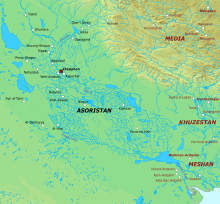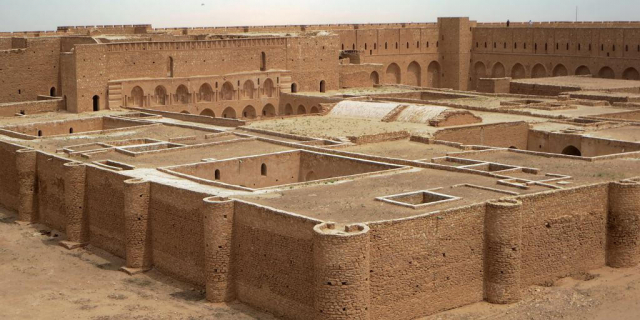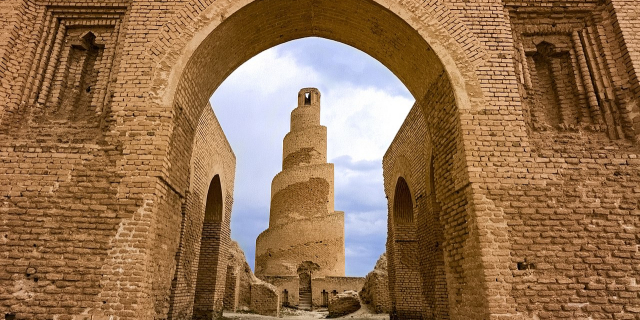Ctesiphon ( TESS-if-on; Middle Persian: 𐭲𐭩𐭮𐭯𐭥𐭭, Tyspwn or Tysfwn; Persian: تیسفون; Greek: Κτησιφῶν, Attic Greek: [ktɛːsipʰɔ̂ːn]; Syriac: ܩܛܝܣܦܘܢ) was an ancient Iranian city, located on the eastern bank of the Tigris, and about 35 kilometres (22 mi) southeast of present-day Baghdad. Ctesiphon served as a royal capital of the Iranian empire in the Parthian and Sasanian eras for over eight hundred years. Ctesiphon was capital of the Sasanian Empire from 226–637 until the Muslim conquest of Persia in 651 AD.
Ctesiphon developed into a rich commercial metropolis, merging with the surrounding cities along both shores of the river, including the Hellenistic ci...Read more
Ctesiphon ( TESS-if-on; Middle Persian: 𐭲𐭩𐭮𐭯𐭥𐭭, Tyspwn or Tysfwn; Persian: تیسفون; Greek: Κτησιφῶν, Attic Greek: [ktɛːsipʰɔ̂ːn]; Syriac: ܩܛܝܣܦܘܢ) was an ancient Iranian city, located on the eastern bank of the Tigris, and about 35 kilometres (22 mi) southeast of present-day Baghdad. Ctesiphon served as a royal capital of the Iranian empire in the Parthian and Sasanian eras for over eight hundred years. Ctesiphon was capital of the Sasanian Empire from 226–637 until the Muslim conquest of Persia in 651 AD.
Ctesiphon developed into a rich commercial metropolis, merging with the surrounding cities along both shores of the river, including the Hellenistic city of Seleucia. Ctesiphon and its environs were therefore sometimes referred to as "The Cities" (Mahuza, Arabic: المدائن, romanized: al-Mada'in). In the late sixth and early seventh century, it was listed as the largest city in the world by some accounts.
During the Roman–Parthian Wars, Ctesiphon fell three times to the Romans, and later fell twice during Sasanian rule. It was also the site of the Battle of Ctesiphon in 363 AD. After the Muslim invasion, the city fell into decay and was depopulated by the end of the eighth century, its place as a political and economic center taken by the Abbasid capital at Baghdad. The most conspicuous structure remaining today is the Taq Kasra, sometimes called the Archway of Ctesiphon.
Ctesiphon was founded in the late 120s BC. It was built on the site of a military camp established across from Seleucia by Mithridates I of Parthia. The reign of Gotarzes I saw Ctesiphon reach a peak as a political and commercial center. The city became the Empire's capital circa 58 BC during the reign of Orodes II. Gradually, the city merged with the old Hellenistic capital of Seleucia and other nearby settlements to form a cosmopolitan metropolis.[1]
The reason for this westward relocation of the capital could have been in part due to the proximity of the previous capitals (Mithradatkirt, and Hecatompylos at Hyrcania) to the Scythian incursions.[1]
Strabo abundantly describes the foundation of Ctesiphon:
In ancient times Babylon was the metropolis of Assyria; but now Seleucia is the metropolis, I mean the Seleucia on the Tigris, as it is called. Nearby is situated a village called Ctesiphon, a large village. This village the kings of the Parthians were wont to make their winter residence, thus sparing the Seleucians, in order that the Seleucians might not be oppressed by having the Scythian folk or soldiery quartered amongst them. Because of the Parthian power, therefore, Ctesiphon is a city rather than a village; its size is such that it lodges a great number of people, and it has been equipped with buildings by the Parthians themselves; and it has been provided by the Parthians with wares for sale and with the arts that are pleasing to the Parthians; for the Parthian kings are accustomed to spend the winter there because of the salubrity of the air, but they summer at Ecbatana and in Hyrcania because of the prevalence of their ancient renown.[2]
Because of its importance, Ctesiphon was a major military objective for the leaders of the Roman Empire in their eastern wars. The city was captured by Rome five times in its history – three times in the 2nd century alone. The emperor Trajan captured Ctesiphon in 116, but his successor, Hadrian, decided to willingly return Ctesiphon in 117 as part of a peace settlement. The Roman general Avidius Cassius captured Ctesiphon in 164 during another Parthian war, but abandoned it when peace was concluded. In 197, the emperor Septimius Severus sacked Ctesiphon and carried off thousands of its inhabitants, whom he sold into slavery.
Sasanian period Map of the southwestern Sasanian province of Asoristan and its surroundings
Map of the southwestern Sasanian province of Asoristan and its surroundingsBy 226, Ctesiphon was in the hands of the Sasanian Empire, who also made it their capital and had laid an end to the Parthian dynasty of Iran. Ctesiphon was greatly enlarged and flourished during their rule, thus turning into a metropolis, which was known by in Arabic as al-Mada'in, and in Aramaic as Mahoze.[3] The oldest inhabited places of Ctesiphon were on its eastern side, which in Islamic Arabic sources is called "the Old City" (مدينة العتيقة Madīnah al-'Atīqah), where the residence of the Sasanians, known as the White Palace (قصر الأبيض), was located. The southern side of Ctesiphon was known as Asbānbar or Aspānbar, which was known by its prominent halls, riches, games, stables, and baths. Taq Kasra was located in the latter.[3][4]
The western side was known as Veh-Ardashir (meaning "the good city of Ardashir" in Middle Persian), known as Mahoza by the Jews, Kokhe by the Christians, and Behrasir by the Arabs. Veh-Ardashir was populated by many wealthy Jews, and was the seat of the church of the Nestorian patriarch. To the south of Veh-Ardashir was Valashabad.[3] Ctesiphon had several other districts which were named Hanbu Shapur, Darzanidan, Veh Jondiu-Khosrow, Nawinabad and Kardakadh.[3]
Severus Alexander advanced towards Ctesiphon in 233, but as corroborated by Herodian, his armies suffered a humiliating defeat against Ardashir I.[5] In 283, emperor Carus sacked the city uncontested during a period of civil upheaval. In 295, emperor Galerius was defeated outside the city. However, he returned a year later with a vengeance and won a victory which ended in the fifth and final capture of the city by the Romans in 299. He returned it to the Persian king Narses in exchange for Armenia and western Mesopotamia. In c. 325 and again in 410, the city, or the Greek colony directly across the river, was the site of church councils for the Church of the East.[citation needed]
 4th century Ctesiphon (Peutinger Map)
4th century Ctesiphon (Peutinger Map)After the conquest of Antioch in 541, Khosrow I built a new city near Ctesiphon for the inhabitants he captured. He called this new city Veh-Antiok-Xusrō, or literally, "better than Antioch Khosrow built this".[6] Local inhabitants of the area called the new city Rumagan, meaning "town of the Romans" and Arabs called the city al-Rumiyya. Along with Weh Antiok, Khosrow built a number of fortified cities.[7] After a campaign in 573, John of Ephesus wrote that no fewer than 292,000 persons had been deported from Dara, Apamia, and other Syrian towns to Veh-Antiokh. John would later cite a letter stating no more than 30,000 prisoners were deported. It's thought that the first number he gave is not to be taken literally.[8]
In 590, a member of the House of Mihran, Bahram Chobin repelled the newly ascended Sasanian ruler Khosrow II from Iraq, and conquered the region. One year later, Khosrow II, with aid from the Byzantine Empire, reconquered his domains. During his reign, some of the great fame of al-Mada'in decreased, due to the popularity of Khosrow's new winter residence, Dastagerd.[9] In 627, the Byzantine Emperor Heraclius surrounded the city, the capital of the Sassanid Empire, leaving it after the Persians accepted his peace terms. In 628, a deadly plague hit Ctesiphon, al-Mada'in and the rest of the western part of the Sasanian Empire, which even killed Khosrow's son and successor, Kavad II.[9]
In 629, Ctesiphon was briefly under the control of Mihranid usurper Shahrbaraz, but the latter was shortly assassinated by the supporters of Khosrow II's daughter Borandukht. Ctesiphon then continued to be involved in constant fighting between two factions of the Sasanian Empire, the Pahlav (Parthian) faction under the House of Ispahbudhan and the Parsig (Persian) faction under Piruz Khosrow.
Downfall of the Sasanians and the Islamic conquestsIn the mid-630s, the Muslim Arabs, who had invaded the territories of the Sasanian Empire, defeated them during a great battle known as the Battle of al-Qādisiyyah.[3] The Arabs then attacked Ctesiphon, and occupied it in early 637.
The Muslim military officer Sa`d ibn Abi Waqqas quickly seized Valashabad and made a peace treaty with the inhabitants of Weh Antiok Khusrau and Veh-Ardashir. The terms of the treaty were that the inhabitants of Weh Antiok Khusrau were allowed to leave if they wanted to, but if they did not, they were forced to acknowledge Muslim authority, and also pay tribute (jizya). Later on, when the Muslims arrived at Ctesiphon, it was completely desolated, due to flight of the Sasanian royal family, nobles, and troops. However, the Muslims had managed to take some of troops captive, and many riches were seized from the Sasanian treasury and were given to the Muslim troops.[3] Furthermore, the throne hall in Taq Kasra was briefly used as a mosque.[10]
Still, as political and economic fortune had passed elsewhere, the city went into a rapid decline, especially after the founding of the Abbasid capital at Baghdad in the 760s, and soon became a ghost town. Caliph Al-Mansur took much of the required material for the construction of Baghdad from the ruins of Ctesiphon. He also attempted to demolish the palace and reuse its bricks for his own palace, but he desisted only when the undertaking proved too vast.[11] Al-Mansur also used the al-Rumiya town as the Abbasid capital city for a few months.[12]
It is believed to be the basis for the city of Isbanir in One Thousand and One Nights.
Modern eraThe ruins of Ctesiphon were the site of a major battle of World War I in November 1915. The Ottoman Empire defeated troops of Britain attempting to capture Baghdad, and drove them back some 40 miles (64 km) before trapping the British force and compelling it to surrender.


























Add new comment